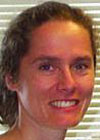 |
|
|
| Author |
Message |
Amy_Clapp

Joined: 23 Mar 2004
Posts: 84

|
 Posted:
Wed Jun 09, 2004 5:15 pm Posted:
Wed Jun 09, 2004 5:15 pm |
  |
June 8/9
Well, yesterday we experienced something that I hadn’t yet experienced in Zhigansk, a full on rain drench. It rained for a solid three hours and continued to drizzle for some time after that. It was good and bad timing for rain. It was good timing because we were going to be spending most of the day getting the samples and ourselves ready to go to Yakutsk, which was an indoor activity (as opposed to sampling, which it would have been miserable if we had to do that). It was bad timing, because if you remember from previous teacher’s journals that I have posted, the runway at the Zhigansk airport is dirt. If it gets to wet, the whole runway turns to mud and the plane can’t land or take off. There is only one plane a week that comes to Zhigansk, so....we got a little worried when it rained, and rained, and rained, that we might end up being in Zhigansk for another week. However, I am writing this from Yakutsk - we flew safely from Zhigansk to Yakutsk just a few hours ago.
So, we did prepare all the samples, which wasn’t so easy. We first had to figure out how many bottles were going to need to be in the frozen cooler and how many were going to need to be in the refrigerated cooler. I am embarrassed to say how long that took three of us to figure out—I will just say that math is an important part of science!!! The final count was 54 frozen bottles, 55 refrigerated bottles, 25 frozen filters, and 1 20-liter sample that doesn’t need to be refrigerated or frozen. The coolers then had to be prepped. Apparently last year, the ice packs that they use in the refrigerated cooler actually froze some of the samples. So, it was important to make sure that the temperatures in each cooler was cold enough but not too cold in the case of the refrigerated samples. There were then a lot of phone calls and communications to the people in Zhigansk where the samples were being kept and a lot of arranging to do to get everything in the right place by the time we were supposed to leave Zhigansk in the morning.

At 5:00 p.m. we were treated to a special farewell performance at the school. There were lots of people there and for almost two hours we got to see traditional dancing and singing performances from the kids of Zhigansk. We also had two teams, Max was the captain of one team—The Friendship Team, and I was the captain of the other team, The Snowdrops (it’s a flower here). We had Russians and other science research team members on our teams. Between the performances we had to answer trivia. The Snowdrops fell behind in the beginning (we were asked a question about the Brooklyn Bridge in New York that we didn’t know the answer to and we answered what is the warmest state wrong—we said Arizona and it was Florida). However, we pulled ahead when we had to list the 50 states in a certain amount of time—we got 47 and The Friendship Team got 40. All in all, I think it was a tie—and no one was really keeping score anyway—it was just for fun. However, I did think to myself how much the Russians knew about our culture, and how little I knew about theirs. They helped me answer questions like what person is on each of the 7 bills in the U.S. Well, I was stumped trying to figure out what the 7 bills were—I knew we had a $1, $5, $10, $20, $50, $100 bill, but my Russian teammates reminded me of the $2 bill.
Although, the trivia game was fun, the real treat was seeing the students dance and sing. I was once again amazed how this arctic culture has kept its traditions alive. All of the dances were traditional Yakutian dances that the children perform at the festivals that they have each year. I am really happy that this group of people is able to be both Russian and keep their Yakut traditional alive too—it makes life so rich to keep up the traditions that have been around for hundreds of years.

After the program at the school, there was another treat that I wasn’t expecting at all. When we got to the lodge we went to the dining room for dinner and I couldn’t believe what was on the table—fresh tomatoes and cucumbers. These were the first fresh vegetables that I had had in 2 weeks and they were heavenly. Now that the ice has broken on the Lena, there is beginning to be more products coming in and out. I am sure that the people who live here are happy about that!
After dinner, some of the older students and their English teacher (Agatha) came to the lodge and wished Oliver a happy birthday (it was his birthday June 6) and then they took us on a picnic. We went for a walk, not too far into the forest from the lodge and saw some really neat trees. They look like pine trees, but they have needles that are deciduous (meaning they shed their needles in the fall and grow new ones in the spring).

Once we got to our picnic site they all pulled out the most amazing spread of food. The highlight though was “shashlik” of reindeer. This was marinated reindeer, put on a stick and cooked over a fire by Savinob (our friend from the beginning of the trip). It was delicious (and this is coming from a vegetarian).

Max had about 30 pieces he loved it so much, and he hasn’t stopped talking about it 24 hours later. We all had a good time talking and learning more about each other. The conversations even got filmed so that it could be used in future English classes. When it got too cold, we packed up and went to have one last look at the Lena (it was midnight again). We said good-bye to our friends and headed back to the lodge to finish up packing.

We all ended up sitting and watching the sun for about an hour and a half. It was low on the horizon and we wanted to see if it was actually going to go down or not (it was about 1:30 a.m.). We watched as it looked as though it was going to go down, but never did; it just began to rise again. That was neat, but what was neater was watching the sun move along the horizon. It moved so quickly. But, did the sun actually move—what was really happening???? |
|
|
    |
 |
|
|
|
View next topic
View previous topic
You cannot post new topics in this forum
You cannot reply to topics in this forum
You cannot edit your posts in this forum
You cannot delete your posts in this forum
You cannot vote in polls in this forum
You cannot attach files in this forum
You can download files in this forum
|
Powered by phpBB 2.0.11
© 2001, 2002 phpBB Group :: FI Theme ::
All times are GMT
| |
